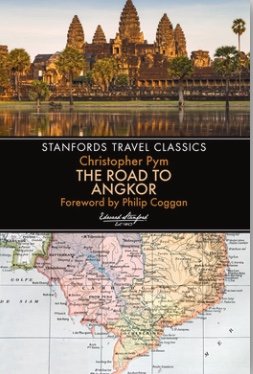The Road to Angkor by Christopher Pym (John Beaufoy Publishing)
There’s a certain kind of British male who confirms Noel Coward’s assertion that mad dogs and Englishmen are attracted to the midday sun and Christopher Pym is a fine example of this. Like many travelers, he was enchanted by Angkor Wat in 1954. However he, in his early twenties, acted upon that enchantment by spending the next three years studying Cambodian history and learning the Khmer language, in London, Paris, and Cambodia. In 1957, armed with a knowledge of that country’s culture, past and present, and with French and Khmer language fluency, the 27-year-old academic sets off on an adventure that verges on insanity. He intends to walk from the part of South Vietnam that had once been the empire of Champa to Angkor Wat, looking for evidence of the ancient road that had supposedly once connected these two strongholds, with 57 resthouses sprinkled along the way. If Pym could find evidence of these resthouses close to his starting point, he’d know the road had actually existed. As it was, at the time he begins this trek, traces of the road had only been found between Angkor and the citadel of Prah Khan in northern Cambodia, with nothing proving a route between Prah Khan and what was once Champa. Ten weeks, he decides, will be enough time for this walk, one that he’s making on foot because he can’t afford horses or elephants as transportation.
But this isn’t complicated enough for Pym. Neolithic tools had been found in the Vietnamese city of Pleiku and he hopes to find more along his route, confirming that a Neolithic culture had spread across the region. He also has a whimsical goal in mind. He’d read about a tribal hillside chieftain, described by an early French explorer as being “young, handsome, brave, quick, eloquent and confident in the future.” This paragon of manly virtues was named Pim and this is enough to prompt his English namesake to look for him, as “an entertaining sidetrack.”
Pym discovers the most arduous part of this enterprise is getting the necessary permits from bureaucrats, which is a prevailing hardship throughout the book. But in the freewheeling spirit that never leaves him, he uses that hurdle to observe the differences between Vietnamese in Saigon, Cambodian monks in a temple near his starting point, and the Chinese in Cholon--”the way they talked, the way they washed, the way they spat.” Pym, unlike many of his countrymen, makes no value judgments nor shows traces of racism, but it becomes clear that he prefers the company of Cambodians, probably because he’s able to speak their language. One of his few moments of petulance surfaces when a Khmer official insists on conversing with him exclusively in French.
Carrying a rucksack that weighs over thirty pounds that he’s filled with 1000 cigarettes and four pounds of candy to give as gifts along the way, as well as a copy of Dante’s Divine Comedy, and wearing “car-tyre sandals,” Pym travels less than 14 miles on his first day and fails to reach his initial goal, Pim’s village. On the following day he meets a man who claims he’s related to Pim, “the son of his brother.”
“It was a recognition worthy of a Greek play.” Although Pim died years earlier, his relatives are delighted that a foreigner has come in search of him and the next few days are spent drinking rice wine and existing in an “alcoholic stupor.”
Drunk or sober, Pym never loses his talent of observation that he cloaks in understatement, delighted by the sight of a Vietnamese woman garbed in a heavy Norwegian sweater, taken aback by nights when the air becomes “quite nippy,” and politely eating “several kinds of unsavory vegetable soup.” When he’s presented with a grilled tiger steak, he overcomes his initial qualms and finds that it’s “most delicious.”
Having found traces of Pim, his next goal is discovering Neolithic tools. Given an axehead that falls into that category, Pym is satisfied, although his prized possession is a much more modern one--a sabre that he’s seen tribesmen carry and has longed to own. “There were none on sale at the market” but when he meets a man who owns two, he’s able to purchase the extra one. Now armed against tigers, Pym is able to disregard his bleeding feet and makes his way through “the sugar palm curtain” that marks the Cambodian border.
Here he finds a flourishing industry of zirconia pit-mining as well as a Khmer Gold Rush near an “unsavory village.” Peasant life, he decides, is “like an antique pitcher with myriad cracks” that’s held together by Buddhism.
Pym turns out to be one of those delightful explorers for whom the journey is more important than the goal and this makes him a fantastic armchair travel companion. His inability to find traces of the road that led from Prah Khan to Champa is thoroughly eclipsed by the stories he gathers on his 450-mile, 7-week odyssey. These make The Road to Angkor a diverting travel narrative--and make me eager to find the book that followed this one, Mistapim in Cambodia. Christopher Pym, where have you been all my life?~Janet Brown
